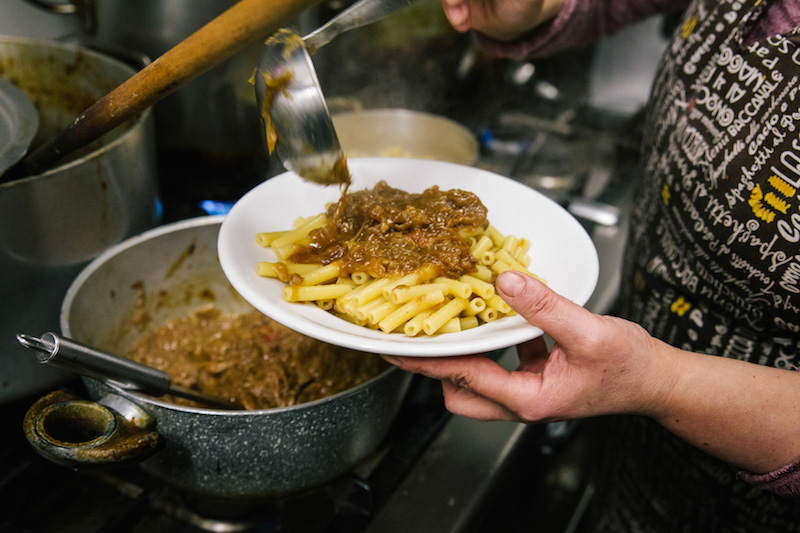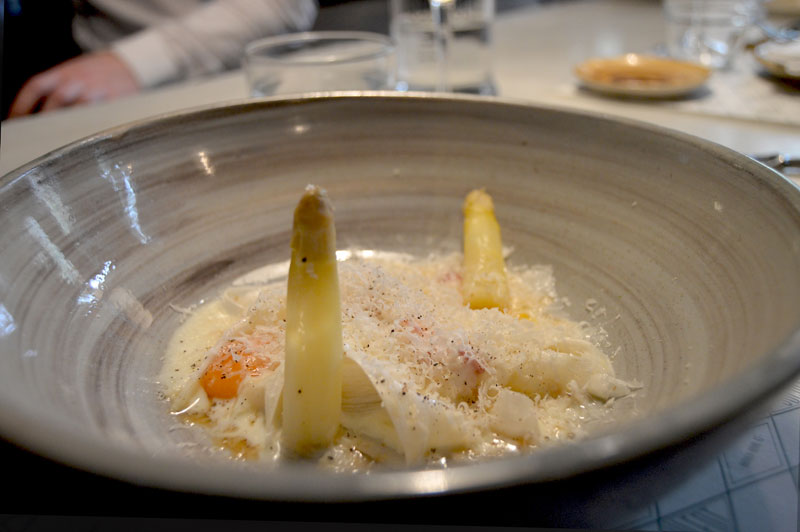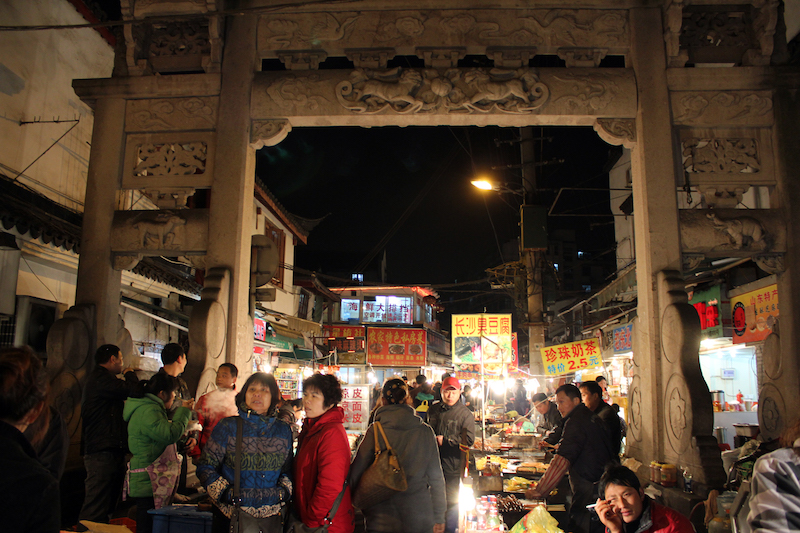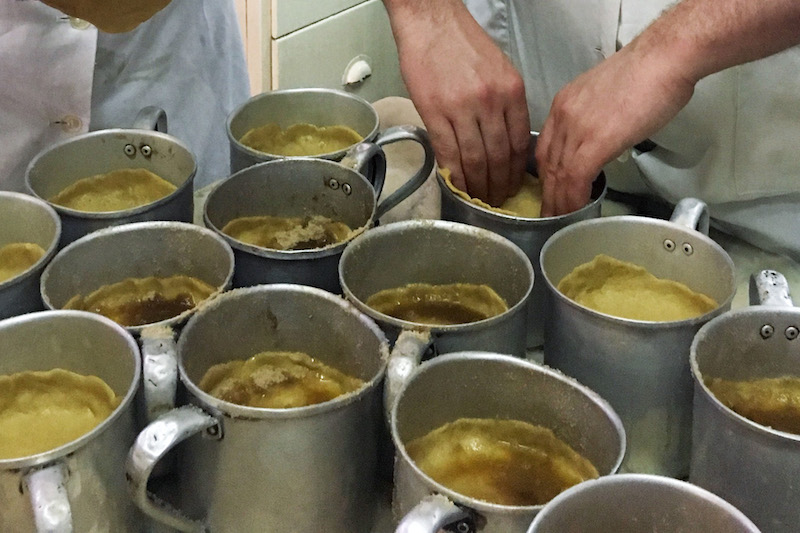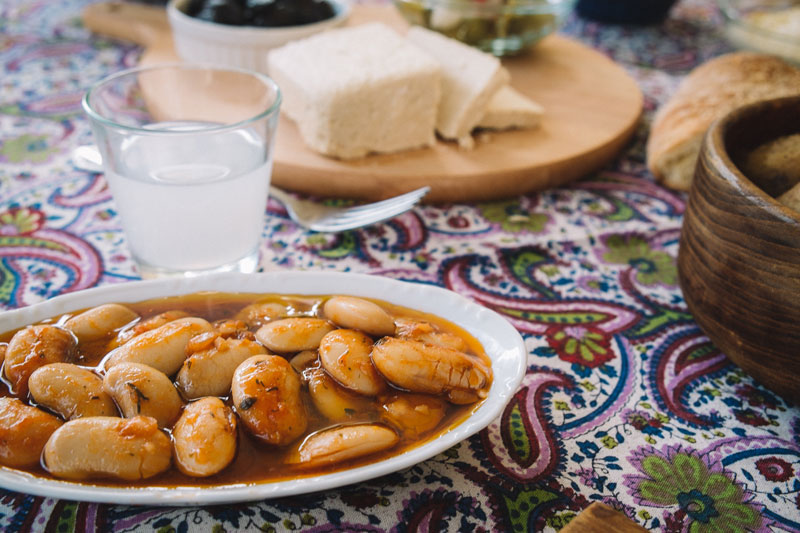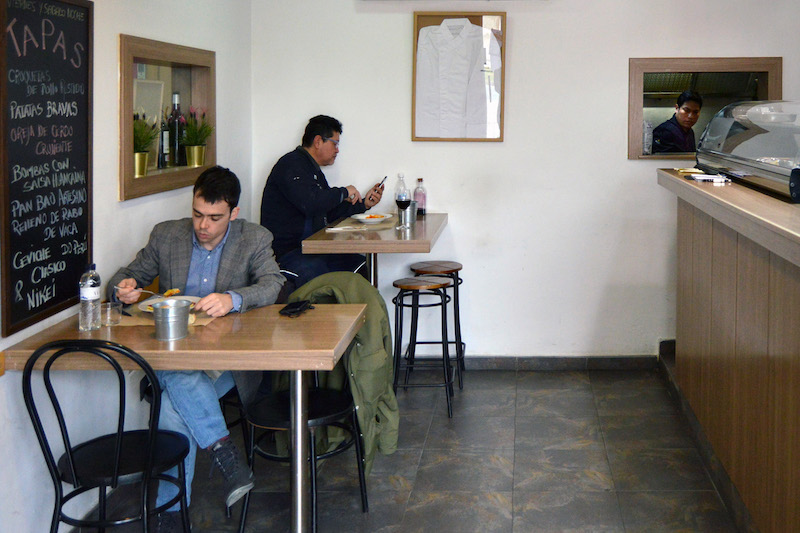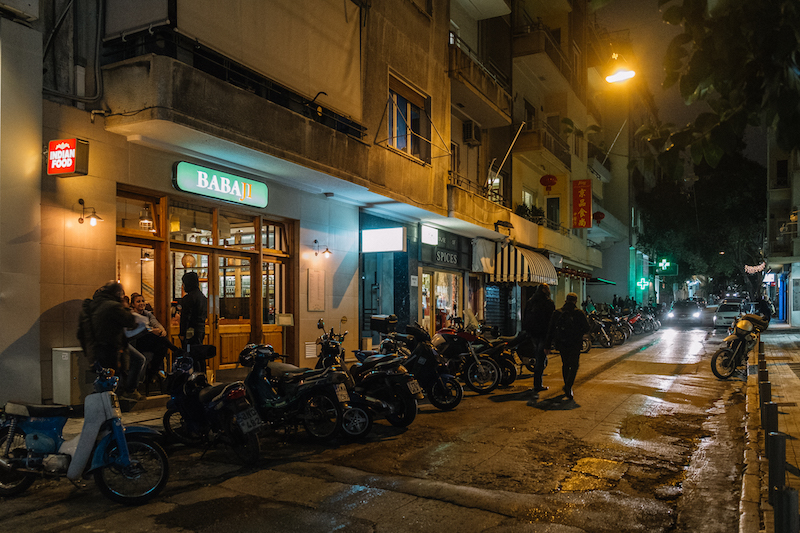We can't find the internet
Attempting to reconnect
Something went wrong!
Hang in there while we get back on track
Search results for
Athens
Spring Surprises: Artichokes Gone Wild on Tinos
Springtime in Greece brings an abundance of fresh produce. Local farmers’ markets erupt with joy at this time of year – in addition to the cheerful vegetables, herbs and beloved wild greens from different regions, the farmers (already sunburnt) shout out to customers with voices that show a clear pride in their harvest. Perhaps our favorite spring crop is the artichoke, a vegetable (technically a flower) that has been widely consumed by the Greeks since antiquity. The artichoke plant doesn’t usually grow over a meter high, and the most scrumptious part is the unopened bud (when it does bloom, the bud grows into a beautiful purple flower resembling a milk thistle).
Read moreBarcelona
Spring Surprises: Edible Flower Season in Barcelona
Flowers may be a visual treat, but they are also a regular ingredient in the cooking of numerous cultures. It’s not uncommon to find roses, violets, orchids, chrysanthemums or any number of flowers – more than 200 in the world are catalogued as edible – adding a pop of color or a surprising flavor to a dish. Flowers have particularly deep roots in Spanish cuisine. They featured most prominently in the food of Al-Andalus, the territory of southern Spain governed by Muslims during the medieval period. Influenced by the Arabs, Andalusian cooks used rose and azahar (orange blossom) to aromatize water and make syrups, jams and pastries.
Read moreMexico City
Spring Surprises: Treasures of the Tianguis in Mexico City
Being the geographic dead center of the country, Mexico City is the hub for all produce heading in any direction. In other words, all roads lead to the sprawling Central de Abastos, the distribution center and wholesaler in the south of the city. “Spring” here is the dry season – the temperatures get hotter by the day until May, even June, when the rainy season begins – but conventional produce is always in season somewhere in Mexico, no matter how parched Mexico City itself might be. But say you’re looking to stick to a “100-mile diet” – surrounding the city there are fertile soils of volcanic valleys as well as high desert regions. So what surprises do they offer in spring?
Read moreShanghai
Spring Surprises: Fresh Pickings of Dragon Well Tea
For 48 weeks out of the year, Meijiawu village is pretty quiet. But in the weeks before and after Qingming, the Tomb Sweeping Festival held every year in early April, the tea terraces looming over the town come to life before sunrise. Tea pickers sweep through the fields, collecting the first buds of the season by hand. These emerald slivers will make up the bulk of the farmers’ annual income, although several more harvests of lesser leaves throughout the year will supplement them. Like wine from Bordeaux, Dragon Well (龙井 – Lóngjǐng) tea comes only from the hills near Hangzhou (although in China, counterfeit leaves – like bottles of Château Lafite – are everywhere). Meijiawu village (梅家坞村) is just a short drive from the actual Dragon Well (or “Longjing”) Village.
Read moreMexico City
A Colorful First Impression in Mexico City
Beans have long played an important part of the daily diet in Mexico City. The variety of beans found in any Mexico City market ranges from the basics (negro, tan bayo, purplish flor de mayo and flor de junio) to more unusual varieties, brought in from all over the country. We spotted these big purple beauties – Ayocote Morado beans – on our Xochimilco walk.
Read moreTbilisi
Spring Surprises: Wild Greens in Tbilisi
Out here in Garikula, our slice of heaven an hour west of Tbilisi, spring is peaking. It started with the plum blossoms and now the apple, pear and cherry blossoms are popping, painting the countryside in patches of white and pink. Walking along a village path with our neighbor Shota, he suddenly stops, bends down and reaches into a wad of weeds and pulls. “Ah-ha,” he says showing us a little bundle of wild asparagus, skinny, green and an appetizing revelation when cooked just right. Back in Tbilisi, this asparagus appeared in the central bazaar a couple weeks ago, along with other welcomed indications that springtime has finally arrived.
Read moreIstanbul
Farewell, Pando: An Istanbul Culinary Legend Passes On
It’s Saturday around lunchtime and business as usual in the bustling Beşiktaş Çarşı neighborhood, as crowds of mostly younger people fill the narrow streets. Down on Mumcu Bakkal Sokak, a pedestrian-only street lined with miniscule shops, a line around the block has been formed by those eager to get into one of the city’s best döner spots. For many of those waiting in line, however, it’s impossible to ignore the scaffolding-covered building just across the way. Though the scaffolding masks most of the historic building, it’s still possible to make out strips of the distinctive baby blue color of what was one of Istanbul’s most beloved eateries: Pando’s kaymak shop.
Read moreNaples
Trattoria Malinconico: In the Court of the Lunch King
If you were to ask me what my ideal lunch is, I would answer without hesitation: paccheri alla Genovese with a large piece of stewed veal shank for the first course, followed by a big ball of buffalo mozzarella (preferably from Tenuta Vannulo, an organic buffalo dairy in Capaccio) with eggplant parmigiana on the side. The backbone of this perfect meal is the Genovese, a simple yet miraculous sauce made of meat (veal, beef or pork) and a heap of onions (red or white). Even those who say they don’t like the taste of onions are forced to recant once they taste the Genovese (after hours spent simmering with the meat, the tenderized and translucent onion slivers have no trace of the astringent smell or bite of raw onions).
Read moreAthens
Lambrinaki: Souvlaki Saviors
Today a residential neighborhood four kilometers north of downtown Athens, Galatsi was once comprised of endless fields where shepherds grazed their flocks. Until the mid-19th century, this area at the foot of the Tourkovounia hill range was uninhabited – the shepherds had free rein. All that changed some 150 years ago when the hills began to be quarried for building materials, particularly lime; workers at the lime kilns eventually became the neighborhood’s first residents. But the local shepherds didn’t immediately pack up and leave. In fact, according to one local legend, they inadvertently gave the new neighborhood its name. To sell their milk to the recently arrived residents, the shepherds would roam the streets shouting “Gala, gala, fresko gala” (Milk, milk, fresh milk). It was this constant cry that supposedly led people to call the neighborhood Galatsi.
Read moreLisbon
Tasca Tables: Like Clockwork at A Provinciana
Most tascas’ walls are covered with tiles, framed family or hometown pictures and soccer teams’ scarves. But inside A Provinciana, located between the neighborhoods of Restauradores and Rossio, the main decorative objects are dozens of original handmade wall clocks. Some work, some don’t, but all have great meaning for Américo, the owner of this establishment that has been around for 70-plus years. “I built them. All of them. Every Sunday, our day off, I sit at my house building these clocks with what I have: old tiles, bits of wood, pieces of barrel,” he says, glancing proud at his creations.
Read moreTokyo
Spring Gone Wild: Tokyo Sansai
One of the great joys of spring in Japan is anticipating the appearance of sansai, or mountain vegetables. When cherry blossoms begin to flutter on warming breezes, hikers take to the hills to forage for the first wild edibles. Supermarkets mount special displays of packaged (and unfortunately often hot-house-raised) young sprouted leaves, shoots and tubers. Restaurants proudly offer up special seasonal dishes, providing an opportunity to bring the freshness of the outdoors to the table, even in the inner city. A bounty of deliciousness awaits those fortunate enough to get out of Tokyo and roam the hills. Fukinoto, taranome and warabi form a trifecta of green vegetables gleaned from mountain walks. Cooks wait all year to prepare dishes of these fragrant yasai veggies.
Read moreIstanbul
Bağdat Ocakbaşı: Licensed to Grill
Istanbul’s T1 tramway is relatively pleasant if you can find a seat, but borders on unbearable if you are on your feet. Back in 2015, we wrote about a trip we took from the line’s first stop all the way to one of its last, which lies way out in the district of Güngören. By the time the tram has made it to this point, it begins to perplexingly share a lane with traffic, voiding the whole point of this type of public transportation. On one weekday evening, we found ourselves standing in a rather contorted position on the beyond-crammed train, a price we were willing to pay for a trip to one of our favorite culinary hotspots. The journey took over an hour. It was well worth it.
Read moreIstanbul
A Meeting of Religions in Karaköy
At this simit bakery in the Istanbul neighborhood of Karaköy, mastic-flavored Greek Orthodox Easter bread is sold alongside sesame-covered kandil simidi, which will be eaten as part of the Miraç Kandili on Friday, April 13, a holy night that celebrates Prophet Muhammad’s miraculous journey to Jerusalem.
Read moreAthens
Ypovrichio: Up From the Ashes
Despite the somewhat rundown, seedy feel of Omonia today, for all of the 19th century and a good part of the 20th the neighborhood was the real center of downtown Athens. “No one lives in Athens if he does not spend at least one hour a day in the Hafteia,” wrote the famous writer and playwright Gregorios Xenopoulos in 1913, referring to the blocks around the intersection of Aiolou and Stadiou Streets, so named allegedly after a 19th-century café in the area owned by a Mr. Haftas. The area was a commercial hub, filled with stores, coffee and sweet shops and hotels. It was a place where people would come to shop and while away the day or the evening. Given its popularity, it’s no surprise that Athens’ first large department stores, like Lambropoulos and Katrantzos Sport, opened here in the early 20th century.
Read moreBarcelona
Spring Fever: The Greening of the City
Barcelona’s urban sprawl makes it easy to forget that the city is adjacent to two fertile regions to the north and south, El Maresme and El Baix Llobregat, which provide numerous hyperlocal culinary treasures throughout the year. In spring as in other seasons, these treasures appear at markets and restaurants, their origins proudly displayed, sometimes even with the names of the specific villages that they come from. The coast and gently sloping mountains of El Maresme are home to numerous villages, three natural parks and beaches. Unsurprisingly, there’s an abundance of seafood here, including gamba de Arenys (Arenys prawns), scampi (escamarlans in Catalan, cigalas in Spanish) and little Mediterranean sand eels (sonsos in Catalan).
Read moreMexico City
Corn Again: An Heirloom Tortilla Revival in Mexico City
“People think it’s a bad thing to be a tortilla-maker,” says Santiago Muñoz. “That’s the mentality we have to change. It should be a point of pride.” Santiago, 25, has spread out two dozen corn cobs, called mazorcas, on the table at the Mexico City warehouse of Maizajo, an heirloom corn tortilla company. The kernels are varied in shape and color: reds, yellows, blues, purples; some narrow, others wide. The diversity of the mazorcas on the table represents the ancestral knowledge of Mexican corn farmers around the country. Each variety comes with a story: that of the town and producer where Muñoz or one of his colleagues sourced it. Santiago points out the different uses for each variety of corn, including pozolero for pozole, and palomero for popcorn.
Read moreRio
Art Chopp: Smoked Success
Five years ago, Diogo Gomes, the owner of Art Chopp, a bar in the Jacarepaguá neighborhood, was seated at one of the bar’s 36 tables. There were no customers: only him, the cook and two waiters. The heavy rain falling outside began to drip from the ceiling and soak the floors. Even wetter, though, was Diogo’s face – he was crying, he later explained to us, because he was sure that he would have to shutter the empty bar and give up on his lifelong dream. In addition to the lack of customers, he was facing a mountain of debts; Diogo was one step away from bankruptcy.
Read moreShanghai
Shanghai: State of the Stomach
In 2017, Shanghai’s longest-running open-air market at Tangjiawan Lu, which had provided the neighborhood with fresh produce, fish, and seasonal foodstuffs for almost 115 years, shuttered its doors. The market and much of the area around the Laoximen metro station were some of the last historical (albeit run-down) structures in an otherwise central area full of expensive new residences. Construction has already begun on the entire city block’s worth of high-rises being built in its place, and the surrounding blocks – like many of Shanghai’s backstreets – are on notice, as the wrecking balls and construction crews continue to reshape the urban landscape at an incredibly fast rate.
Read moreShanghai
Shanghai: State of the Stomach 2018
In 2017, Shanghai’s longest-running open-air market at Tangjiawan Lu, which had provided the neighborhood with fresh produce, fish, and seasonal foodstuffs for almost 115 years, shuttered its doors. The market and much of the area around the Laoximen metro station were some of the last historical (albeit run-down) structures in an otherwise central area full of expensive new residences. Construction has already begun on the entire city block’s worth of high-rises being built in its place, and the surrounding blocks – like many of Shanghai’s backstreets – are on notice, as the wrecking balls and construction crews continue to reshape the urban landscape at an incredibly fast rate.
Read moreIstanbul
Dose & Istos Café: Greek Revival
A café at its best is so much more than the sum of its parts: it’s a place where people can easily mingle, share ideas, and dertleşmek, or commiserate over their troubles, all while imbibing caffeine. At the same time, it’s a place where visitors might feel an invisible thread of common beliefs connecting them, an unspoken camaraderie, even if they don’t socialize with anyone. This community spirit runs strong in Dose & Istos Café, a new Rum (pronounced “room,” the name given to Turks of Greek descent) café in the heart of Beyoğlu. When we first went one rainy Sunday evening on a tip from a friend, we didn’t remember the exact address, just general directions that it was off Istiklal Street, near Galatasaray Lycée.
Read moreLisbon
Folar de Folhas: Our Favorite Folares
A visit to a pastelaria in Lisbon in the lead up to Easter brings with it new surprises. Alongside the usual pastries and cakes, you’ll spot folares, loaves of sweet bread, some topped with hardboiled eggs, and many surrounded by a colorful assortment of almonds. This type of bread, which contains ingredients forbidden during Lent, has long been associated with Easter and the feasting that occurs on this holiday. “After the winter months and the long fast during Lent, the Easter brings an intense activity in terms of culinary preparations and the exchange of cakes, namely the folares,” writes Mouette Barboff in her book A Tradição do Pão em Portugal (Bread in Portugal).
Read moreBarcelona
Agreste de Fabio & Roser: Good Weed
Up in Barcelona’s hills, in the El Coll neighborhood, where the city ends and the sky is cut by the spiky shapes of the pine trees in Collserola Park, Agreste de Fabio & Roser is sprouting up. Emphasizing sustainability and healthy eating, the restaurant is creating delicious dishes that merge Catalan and Italian traditions with contemporary flourishes. Room manager Roser Asensi and her partner, chef Fabio Gambirasi, created this project (the name means “bad weed” in Spanish) less than a year ago and people are already singing their praises. On a recent visit, we could hear words of admiration from different guests flying around the room over the course of our meal.
Read moreAthens
Less Is More: Celebrating Lent in Greece
From Rio to Venice, from Cologne to New Orleans and from Patras to towns all over Greece, Catholics and Orthodox (along with believers and nonbelievers of every description) celebrate Carnival – the three weeks preceding Lent – with parades, masquerades, pranks, Dionysian revels and Lucullan feasts focusing on roasted meats. After all, the word “carnival” is thought to have come from the Italian carne levare or “abstain from meat” – which is also the meaning of the Greek Apokreas – and heralded a time when many religions prohibited consuming flesh during the sacred fast before Easter.
Read moreBarcelona
Chocolate Wonderland in Barcelona
In the weeks leading up to Easter, the best confectioners in Barcelona erect astonishing and fantastical chocolate constructions, called monas de Pascua, and display them in shop windows. For some lucky children, these chocolate sculptures will be gifted to them by their godparents on Easter Sunday.
Read moreTbilisi
Dukani Racha: Tbilisi’s Oldest Greasy Spoon
We returned to Tbilisi in 2002 with the intention of staying one year. On that first day back, our friends took us to a chummy brick-walled cellar in Sololaki. There was enough sunlight coming down through the door to illume low pine tables and seating for fifty people max. In a refrigerated counter, menu items were displayed: beef tongue, tomato and cucumber salad, assorted cheeses, badrijani (sliced fried eggplant stuffed with a garlicky walnut paste), all the standard stuff. It was a Georgian greasy spoon, for sure, with a kitchen that would make a health inspector shudder, but the khinkali were really good, and the house wine was as decent as it comes. The name of the place was Dukani Racha. Little did we know people had been coming here for decades.
Read moreIstanbul
Back to the Land: Urban Turks Tackle Rural Life
When Buket Ulukut first moved from Istanbul to a rural plot of land in the foothills of the Taurus Mountains in southern Turkey, she was leading a double life. “I’d be taking calls from clients in Europe while out amidst the rows of peppers and eggplants, hoping they didn’t hear the rooster crowing in the background,” says Ulukut, who worked in the textile industry before establishing Tangala Goat Farm in Muğla’s serene Yaka village. Since Ulukut settled in the area in 2008, her herd has grown from two goats to more than 50, producing milk that is made on-site into artisan cheeses sold throughout Turkey. Over the same decade, the number of Turks swapping the city for the countryside has also multiplied, driven by rising urban stresses and an increasingly stifling political climate.
Read moreLisbon
Casa dos Passarinhos: Rare Bird
The name Casa dos Passarinhos (House of Little Birds) seems to give everyone pause – whenever we talk about or recommend the restaurant, almost all of our conversation partners flash a nervous smile, seemingly wondering, “Are little birds what they serve?” Far from it (although some restaurants do specialize in serving thrushes). This popular restaurant, which has been around since 1923, took its name from the birds – sparrows, specifically – that used to be allowed to fly freely inside the restaurant. Many years before Hitchcock made them the villains in his movie “The Birds,” original owner José dos Santos Gomes made them the heroes of this backstreet spot in Campo de Ourique, on the border with the Amoreiras neighborhood.
Read moreNaples
Pizzeria e Trattoria Vigliena: Spaghetti with Clams, A Primer
One day, or so the story goes, a group of tourists asked an elderly priest in Naples which churches were really worth visiting. The priest replied, “There are many churches, but have you tried the spaghetti with clams?” Even a man of God recognizes the sacred bond established between two people sharing a plate of spaghetti with clams in a Neapolitan trattoria. So we consider it our moral duty to advise you how to order your spaghetti with clams and where to eat it.
Read moreTokyo
Sakura Season 2018: How to Celebrate in Tokyo
It’s that time of year when armies of sakura (cherry blossom) trees in Tokyo stand poised to break into bloom and people are finalizing plans for hanami, or cherry blossom viewing parties. This yearly ritual, which takes place all over Japan, is a tradition that’s been around for over a thousand years, as sakura are a beloved and important symbol in Japanese culture. Multitudes of cherry blossoms will bloom in lavish displays of wonderful pink magic all over Japan, starting on the southern island of Kyushu in early March and moving north to Hokkaido by the end of May. Weekly and then daily newspaper and Internet updates inform local populations on the progress of the blooms from initial buds (10 percent, then 20 percent, etc.) to the final full display (mompai!).
Read moreAthens
Peinirli Ionias: Talking Dough
Since its name derives from the Turkish word peynir (cheese), it’s no surprise that Athens’ best peinirli (πεϊνιρλί, “with cheese”), a boat-shaped flatbread similar to pide in Turkey and khachapuri in Georgia, is usually found at old, specialized shops or eateries owned by families who originally came from Asia Minor or Pontus, the Greek name for the southern coast of the Black Sea, in the early 20th century. So when Spyros, the owner of Peinirli Ionias in Ambelokipoi, one of the most popular peinirli takeaways in downtown Athens, casually mentions that he originally hails from the Ionian island of Corfu – nowhere near Asia Minor, another name for Turkey’s Anatolia region – we are left scratching our heads. Sensing our confusion, he quickly adds that he learned the art of peinirli-making directly from the source, so to speak: his father- and mother-in-law, who both emigrated to Athens as part of the 1923 population exchange between Greece and Turkey.
Read moreLisbon
A Time Out for Lisbon’s Market Makeovers?
“It’s good for tourists, not for us.” While this can sadly be said about many things, Anabela, the woman we are speaking to, is referring to the transformation of Mercado da Ribeira, Lisbon’s historic public market, where she co-runs a small grocery store. Originally built as a predominantly wholesale food, fish and flower market in 1771, Ribeira today shares its space with Mercado Time Out, financed by the venture capital firm that controls the publishing franchise in Portugal, which has occupied the central section of the market since 2014. Time Out’s concept: an “editorially” curated gourmet food hall. Selling the best of Portugal – from croquettes and custard tarts to seafood and steak – it is now a top attraction, with 24 restaurants, eight bars, a dozen shops and a high-end music venue.
Read moreTokyo
Behind Bars: Getting Tight at Tokyo’s Tight Bar
If it weren’t for the dozens of brightly lit signs and paper lanterns promising libations of every sort, you might mistake the two narrow alleys alongside the train tracks on the northeast side of Shibuya station for a derelict apartment block. In reality Nonbei Yokocho (AKA Drunkard’s Alley) is one of Tokyo’s few remaining yokocho (side street) bar districts. Like the much larger and better-known Golden Gai in Shinjuku, Nonbei Yokocho is a collection of aging and tightly packed microbars. Each watering hole is scarcely more than a few square meters, and if longtime regulars aren’t taking up the scant floor space, newcomers may try any number of doors before they find an empty seat.
Read moreLisbon
Serious About Ginja
Lisboetas are serious about their ginja, a liqueur made from a sour cherry of the same name. The fruit might not be so sweet but is fortunately well suited to being turned into this smooth drink, which is enjoyed both as an aperitif and digestif. Our Culinary Crossroads walk in Lisbon wouldn’t be complete without a tipple of the good stuff.
Read moreQueens
Shelly’s Café: Pluck of the Irish
To her friends, Michelle Boyce, the owner of Shelly’s Café, is “Michelle.” That was the name called out by many customers, when arriving or departing, as we sat and talked in her sunny dining area on a recent afternoon. She is, to be sure, also “Shelly,” a diminutive bestowed on her by her mom in Newry, County Down, one of six counties that form Northern Ireland. Years later and an ocean away from that childhood home – Michelle left Newry for New York as a young adult in 2010 – she told us of her continuing “passion to recreate my mom's home cooking.” In that sense, the name “Shelly’s Café” evokes both mother and daughter.
Read moreTbilisi
Chacha Corner: Moonshine Museum
The day two airliners flew into the World Trade Center, we were in Lagodekhi, an east Georgian village on the border with Azerbaijan. We had been in a total daze trying to comprehend the scope of the tragedy from a village halfway around the world where our hosts were offering solace through the bottle. Zaur, a neighbor, showed up the morning of the twelfth with a Borjomi mineral water bottle of his chacha and made breakfast toasts to the victims of New York, to peace, to bloody revenge and so on. Needless to say, we were well under the influence by lunch time and ended up arm-in-arm at a local stolovaya (canteen) with a platter of frankfurters and bread before Zaur put us in a minibus home.
Read moreBarcelona
El Practic: The Itinerant Gourmet
El Practic doesn’t look like much at first glance. The small restaurant is sparsely decorated and populated by a few naked tables. Its location – in front of two massive buildings under construction in Cornellá de Llobregat, an industry-heavy municipality on the southwestern periphery of the Barcelona metropolitan area – is not where many people would choose to set up a restaurant. But chef Andrés Huarcaya was certain people would come. “I’ve worked in so many places,” he said, “and one day it hit me that if you do good work – this is the key – then people will come. On this street, nobody passes by at night. And yet we are always packed on Fridays and Saturdays – totally packed!”
Read moreIstanbul
Market Watch: Semt Pazarları, Civic Life Perfected
“Two kilos five liraaa! Two kilos five liraaa!” bellowed a young and exuberant vendor of tomatoes to the ongoing stream of frugal-minded shoppers making their way through the snaking Tarlabaşı Sunday Market. Hundreds of sellers of fresh produce, dairy, seafood, kitchenware, clothing, smuggled tobacco, jewelry, fresh baked goods and numerous other items set up side by side in the central Istanbul quarter of Tarlabaşı every Sunday, weaving an extended path down a backstreet that incorporates both unbridled chaos and strict organization. It is just one of hundreds of similar weekly semt pazarları, the beloved Istanbul neighborhood bazaars that offer some of the cheapest prices on the widest variety of goods the city has to offer, while at the same time serving as a critical element in maintaining the vitality of Istanbul neighborhood life.
Read moreLisbon
Business as Usual at Zé dos Cornos: Tasca Tables
Forty years ago, José was the most popular boys’ name in Portugal. It had been the undisputed leader in that category for several decades. But trends change, and in 2017 José didn't even crack the top 20. So, it's quite possible that the future will bring an influx of restaurants named after Santiago, the top choice for the last two years. But as we write this there are still a lot of Zé(s) – the shortened form of José – around town. Zé da Mouraria is famous for its magnificent roasted codfish. Zé Varunca serves great food from Alentejo, the home region of this particular José. And the list goes on: Zé dos Frangos, Zé Carioca, Tasca do Zé and, of course, Zé dos Cornos.
Read moreBarcelona
Pirineu en Boca: Straight From the Mountains
There are many legends and myths surrounding the Pyrenees. Some claim that the divine hero Hercules created the mountains by piling up rocks as a tomb for his love Pyrene, who had died in one of the area’s forests after being bitten by a snake. While a romantic story, the Pyrenees are much more than a mausoleum and a symbol of mythic love – they are also the birthplace of Basque culture and a disputed border between Spain and France, a place crisscrossed by Roman roads and sprinkled with Roman architecture, a key point in the Camino de Santiago (Way of Saint James) and a legendary land for the Catalans.
Read moreAthens
Babaji: Opportunity Kitchen
Greek food has been experiencing a renaissance in recent years – an unexpected byproduct of the country’s economic struggles. Greeks are rediscovering their culinary roots, and the world outside is also taking a new look at the country and its cuisine, raising Greece’s profile as a culinary destination in the process. But running parallel to this tale of economic stagnation and culinary resurgence is the story of economic migrants and refugees, people who fled to Europe in the hopes of finding a better life. While the focus as of late has understandably been on the Syrian refugee population living in camps throughout Greece, economic migrants from a wide range of countries have been quietly toiling away in Athens for years.
Read moreRio
Pop up Peru: Home Cooking
Over the last couple of years, Rio de Janeiro’s food scene has experienced a Peruvian invasion. Encouraged by the buzz of the 2016 Olympic Games, more than 10 restaurants and bars focused on Peruvian cuisine opened up shop in Rio. But many of those spots are fine dining establishments, plating up the kind of sophisticated cuisine found in Lima – the capital of Peru is a culinary powerhouse and one of the best places to eat in the world. But there are exceptions. We stumbled on one in an old house in the Botafogo neighborhood. At this restaurant, called Pop up Peru, there are no fancy decorations, nor any kind of complex contemporary recipes. Even Lima’s influences are conspicuously absent.
Read moreIstanbul
Erzincan Tandır Ekmeği: Village Loaves for City Folks
In the Kurtuluş district of Istanbul, we’ve lately been exploring links to older, nearly lost Istanbul culinary traditions. Spending time in the sweetshops, milk bars and şarküteri of this district, we’ve seen a glimmer, if faded, of the “Old Istanbul” that people remember from the 1950s and '60s, when the city’s historic minorities – Greeks, Armenians and Jews – played a prominent role in the culinary scene of the city. It’s a complex and endlessly fascinating subject, one that never fails to spark our curiosity. And then we were distracted by the smell of fresh bread. Fresh lavaş, to be more specific, being hoisted out of a fiery hole in the floor on a blackened hook by the sturdy Gül Hanım.
Read moreNaples
Building Blocks: In Naples, A Taste for Fire
Once the Christmas nativities are packed away, after the New Year’s cotechino sausage and good luck lentils have been eaten and the Befana witch has filled epiphany stockings with candies, something strange happens in the old center of Naples. It erupts in flames. As the January sun sets, just as the days begin to lengthen, Neapolitan men light small bonfires in the dark alleys and decadent piazzas that lurk beyond Via Foria, the ancient boulevard that slices through the town’s Forcella and Rione Sanità quarters. The fires begin small. Men merrily douse bits of the Gazzetta dello Sport with gasoline, searching specifically for errant wrinkled pictures of Higuaín, loathed former Napoli footballer traded to Juventus.
Read moreLisbon
A Casa do Bacalhau: In Cod We Trust
Scan almost any menu in Lisbon and you’re bound to find bacalhau (salt cod) in some form. That should come as no surprise: Lisboetas have long had a taste for this preserved fish, which can be found in a number of traditional dishes. Yet despite being seemingly everywhere, there are very few spots that focus exclusively on bacalhau. A Casa do Bacalhau, as its name suggests, is one of them, using salt cod in almost everything it serves except dessert. Open since 2000 in the Beato neighborhood, the restaurant is housed inside the old stables of the Duques de Lafões palace, which was built after the 1755 earthquake.
Read moreTbilisi
Bina 37: Wine Cellar in the Sky
We are on the eighth floor terrace of a relatively new apartment building in the Vedzisi neighborhood, nodding our heads with joker grins like gawkers at a freak show. The view is as spectacular as they come in mountainy Tbilisi, but that’s not what we’re chuckling at. There are 43 ceramic urns – kvevri – buried almost a meter and a half into a bed of sand and perlite in what was supposed to be a swimming pool for a nine-year-old boy. But in an epiphanic moment, the child’s father, 43-year-old doctor, Zura Natroshvili, decided to build a marani in the sky instead. The father of modern advertising, David Ogilvy, once said, “The best ideas come as jokes.” Dr. Natroshvili would probably agree. His friends thought he needed psychiatric help when he first shared his idea.
Read moreBarcelona
Cava: A Toast to Spain's All-Day Sparkler
Cava, the Spanish sparkling wine, is an indispensable part of celebrations in Barcelona – though we’re happy to find other reasons to raise a glass of the stuff any day of the week (particularly on a dreary Monday). It’s produced using the same méthode traditionnelle that is used for French champagne: after the base wine is fermented from the pressing, it’s bottled, usually with a mixture of sugar and yeast, to undergo a second fermentation to produce that ebullient fizz.
Read moreAthens
SAE: Eat Like an Egyptian
At first bite, the flavors don’t seem that different. But then comes a rush of spice or an unfamiliar herbal note, and it’s clear that this isn’t standard Greek fare – in fact, it’s not Greek at all. It may serve a community of Greeks, but – as its name implies – the Association of Greeks from Egypt (SAE) specializes in Egyptian food. What began as a small canteen providing the familiar tastes of home for the association’s members has grown over the years into a popular local hangout, dishing up traditional Egyptian dishes to Athenians of all persuasions. Despite the long and storied history of Hellenistic culture, which stretches into antiquity, the modern state of Greece is relatively young, and like many nation states, its story is bound up in migration.
Read more






